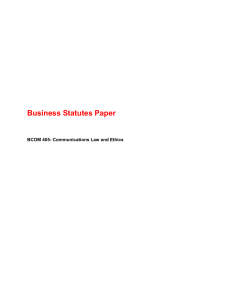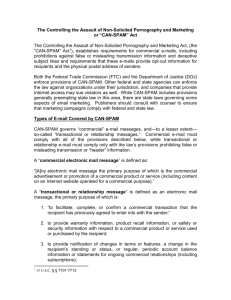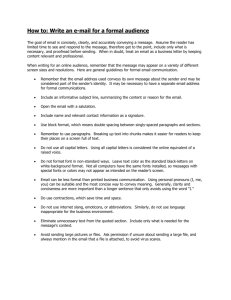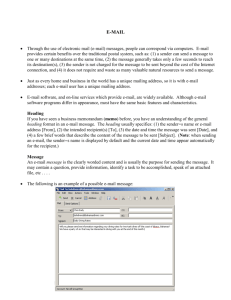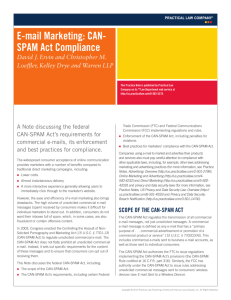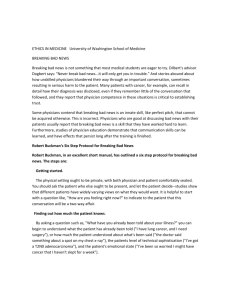can-spam - Pennsylvania Association of Realtors
advertisement
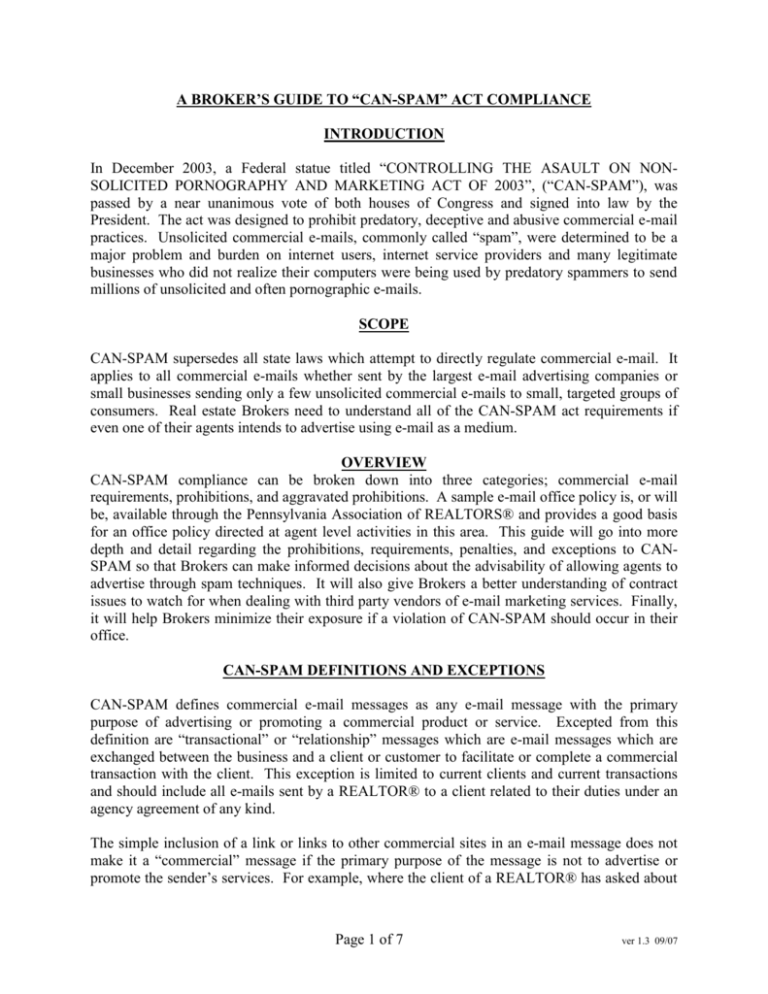
A BROKER’S GUIDE TO “CAN-SPAM” ACT COMPLIANCE INTRODUCTION In December 2003, a Federal statue titled “CONTROLLING THE ASAULT ON NONSOLICITED PORNOGRAPHY AND MARKETING ACT OF 2003”, (“CAN-SPAM”), was passed by a near unanimous vote of both houses of Congress and signed into law by the President. The act was designed to prohibit predatory, deceptive and abusive commercial e-mail practices. Unsolicited commercial e-mails, commonly called “spam”, were determined to be a major problem and burden on internet users, internet service providers and many legitimate businesses who did not realize their computers were being used by predatory spammers to send millions of unsolicited and often pornographic e-mails. SCOPE CAN-SPAM supersedes all state laws which attempt to directly regulate commercial e-mail. It applies to all commercial e-mails whether sent by the largest e-mail advertising companies or small businesses sending only a few unsolicited commercial e-mails to small, targeted groups of consumers. Real estate Brokers need to understand all of the CAN-SPAM act requirements if even one of their agents intends to advertise using e-mail as a medium. OVERVIEW CAN-SPAM compliance can be broken down into three categories; commercial e-mail requirements, prohibitions, and aggravated prohibitions. A sample e-mail office policy is, or will be, available through the Pennsylvania Association of REALTORS® and provides a good basis for an office policy directed at agent level activities in this area. This guide will go into more depth and detail regarding the prohibitions, requirements, penalties, and exceptions to CANSPAM so that Brokers can make informed decisions about the advisability of allowing agents to advertise through spam techniques. It will also give Brokers a better understanding of contract issues to watch for when dealing with third party vendors of e-mail marketing services. Finally, it will help Brokers minimize their exposure if a violation of CAN-SPAM should occur in their office. CAN-SPAM DEFINITIONS AND EXCEPTIONS CAN-SPAM defines commercial e-mail messages as any e-mail message with the primary purpose of advertising or promoting a commercial product or service. Excepted from this definition are “transactional” or “relationship” messages which are e-mail messages which are exchanged between the business and a client or customer to facilitate or complete a commercial transaction with the client. This exception is limited to current clients and current transactions and should include all e-mails sent by a REALTOR® to a client related to their duties under an agency agreement of any kind. The simple inclusion of a link or links to other commercial sites in an e-mail message does not make it a “commercial” message if the primary purpose of the message is not to advertise or promote the sender’s services. For example, where the client of a REALTOR® has asked about Page 1 of 7 ver 1.3 09/07 picking a home inspector, sending an e-mail message with links to sites of home inspection companies is primarily done to fulfill the agency duties of the licensee. On the other hand, where the same agent sends out a message to past clients recommending that they consider using a certain home inspector should one be necessary in the future, that would be considered an advertisement subject to this Act. Compliance Tip: Whenever there is a question of whether or not an e-mail message is regulated by CAN-SPAM it is strongly recommended that the sender comply with the Act to avoid any unintended violations. Compliance Tip: If the purpose of an e-mail message is to “promote a commercial product or service” then the law applies regardless of the identity of the recipient unless there is a specific exception that can be invoked. Specifically, where agents are sending listing information to other agents or brokers in an effort to sell a property, the message would be considered a commercial e-mail under the law because the sending agent is primarily promoting a product or service. Note that simply belonging to the same organization (MLS or Association) is not an exception to the law; messages sent to brokers or agents that promote listings must follow all the rules below, including the opt-out provision. E-MAIL REQUIREMENTS UNDER CAN-SPAM The CAN-SPAM Act requires all commercial e-mails to contain the following: 1. A valid opt-out mechanism and notice. The act requires that either a function return e-mail address or other internet based response mechanism be included in each commercial e-mail. There must also be a clear and conspicuous notice to the recipient telling the recipient how to use the opt-out mechanism if they no longer wish to receive commercial e-mails from the sender. The opt-out mechanism must remain active for at least 30 days after the final commercial e-mail is sent from the sender’s current e-mail address. The sender must comply with the opt-out request within ten business days after the opt-out request is sent to the sender by the original recipient. Compliance Tip: It is strongly recommend that any Broker who allows agents to use commercial e-mail advertising techniques should develop and maintain a centralized “do not spam” or “opt-out” list in the office. The opt-out list should be available to all agents using this method of advertising. The use of a centralized list is necessary because a request to one agent of the Broker to stop sending spam to a recipient is considered under CAN-SPAM to apply to the entire Brokerage. The Can-Span Act also has provisions which make not only the individual sender of the e-mail responsible for any violations, but also imputes those violations to the business for which the individual works. 2. A valid physical postal address of the sender must be clearly and conspicuously displayed in the commercial e-mail message. Compliance Tip: In order to comply with this regulations of the State Real Estate Commission all associate broker and salesperson advertisements must contain the name Page 2 of 7 ver 1.3 09/07 and telephone number of their employing Broker in addition to their own. To comply with both CAN-SPAM and the State Real Estate Commission’s regulations it will be necessary for the valid physical postal address of the Broker to be listed as well. Agents should not include their home office address as this may be interpreted by the State Real Estate Commission as a claim that they are operating branch office out of that location. 3. All commercial e-mails must provide clear and conspicuous notice that the message is an advertisement or solicitation. This notice does not need to appear in the subject line of the message, but must be located within the message itself at a minimum. CAN-SPAM PROHIBITIONS The CAN-SPAM Act prohibits the following practices with respect to commercial e-mail messages: 1. It is unlawful to send a commercial e-mail message that has “header” information that is false or misleading. Header information includes information such as the sender’s e-mail address, the originating domain name associated with the message, along with source, destination and routing information. The majority of this information is not visible to the recipient, although some of it may be included in the “from” line of a message. It is this information that is used by most anti-spam filter technologies to block unwanted spam, hence the reason why deceptive header information is prohibitated. Compliance Tip: Most header information is automatically attached to outgoing e-mail messages by your computer, local network and/or internet service provider (“ISP”). You may contact the persons in charge of technical operation of any of those items to confirm that your header information is accurate. Most problems with improper header information will occur when REALTORS® contract with third party vendors to provide electronic mail advertising services. Brokers should make it an office policy that all such contracts have to be reviewed by the Broker or their designee. The reviewer should ensure that such contacts state that the vendor will comply with all applicable law and regulations and should specifically include the CAN-SPAM Act of 2003. Vendors should also agree to indemnify the Broker for any violations caused by the Vendor’s actions. 2. The use of header information that is accurate but fraudulently obtained is also prohibitated. This would occur when the person sending the e-mail message fraudulently acquires the e-mail address, domain name or internet protocol address used to send the message. Another tactic prohibited by the Act is the use of a second computer to relay the message thereby disguising its origin. 3. The use of deceptive subject headings is prohibited. Subject headings are under the control of the person who sends the message and always appear on the screen of the recipient. The standard set in the CAN-SPAM Act is that a message is misleading if a reasonable recipient would be mislead regarding the contents or subject matter of the Page 3 of 7 ver 1.3 09/07 message. This is a fairly ambiguous standard and it is recommended that subject lines be treated as stringently as possible to avoid being labeled as misleading. 4. Sending commercial electronic mail to recipient who has “opted out.” The only time spam may be sent to the e-mail address from which an opt-out message has been received is when the sender subsequently obtains the express agreement of the recipient to begin receiving spam messages from that sender again. Any such agreement should be obtained in writing. AGGRAVATED CAN-SPAM VIOLATIONS The following practices may subject a violator to increased penalties under CAN-SPAM: 1. The electronic harvesting of e-mail addresses from other’s web sites without the web site operator’s permission. 2. The use of a technique also called a “dictionary attack.” This prohibited technique uses automated means to generate possible e-mail addresses by combining names, letters and numbers into different combinations. 3. The use of automated methods to create multiply e-mail accounts for sending spam. 4. Knowingly allowing your computer to relay e-mail messages from another sender in order to disguise the actual origin of the message. Compliance Tip: These aggravated violation techniques require a fairly high level of technical sophistication. REALTORS® who do not carefully choose legitimate third party vendors to handle their e-mail advertisements run the greatest risk of committing these aggravated violations. It is advisable to ask potential vendors for references, check with the Federal Trade Commission or Pennsylvania Attorney General’s office to see if any Complaints have been filed against the vendors and to have a person with proper computer and/or legal expertise review the proposals and contracts of any vendor of such services. MOBILE MESSAGING Beginning on March 9, 2005, in addition to the restrictions and prohibitions above, all senders of commercial e-mails must check their e-mail lists against a list of wireless domains maintained by the Federal Communications Commission (FCC). Domain names are the part of an e-mail address that follow the “at” sign. For example, in the address donotcall@parealtor.org, the domain name is “parealtor.org.” Wireless domains are Page 4 of 7 ver 1.3 09/07 those registered for use by providers of wireless messaging technology, and are used only as domain names for wireless devices. Messages sent to a wireless domain are now classified as a "mobile service commercial messages" ("MSCM"). Senders may send an MSCM to a recipient only if the recipient has provided “express prior authorization.” This means that senders must check their e-mail lists at least once a month to determine if any recipients are using wireless domains, and if so, must obtain oral or (preferably) written authorization to send messages to those addresses. In the alternative, the sender can block those addresses from receiving any e-mail from the sender. From a practical standpoint, is that it is unlikely that many consumers would use a wireless domain as their primary e-mail address. Most are more likely to have mail forwarded from a “standard” e-mail account to their wireless device instead. Since the rules don’t apply to forwarded messages, this would not affect the sender. As a simple means of protection, licensees should screen e-mail addresses before adding them to a database. If given an address that looks like a wireless domain, best practice will be to ask for another address instead. Simply put, if there are no wireless domains into a database, there is no risk of sending a message in violation of this rule. WHO IS LIABLE? Both the physical sender of an e-mail message and the person who initiated the sending of the message (i.e. someone who hires another to send spam on their behalf) are liable for CANSPAM violations. In addition, the Act imputes liability for violations to the business whose goods or services are being advertised through unlawful commercial e-mail if the business: 1. Knows or should know that their goods or services are being promoted in an unlawful manner; 2. The business receives or expects to receive an economic benefit from the advertisements; and, 3. The business took no reasonable action to either prevent the transmission of the unlawful messages or to detect the transmissions and report them to the FTC. Compliance Tip: It is strongly recommended that any contract with a third party vendor providing commercial e-mail services include a provision allowing the Broker to immediately terminate the agreement and stop all further transmission of e-mails on their behalf if they know or suspect that the vendor has committed a violation of CAN-SPAM. Similarly a Broker who discovers one of their agents is violating the act should immediately, and in writing, prohibit the agent from sending any further improper or unlawful e-mails and take appropriate disciplinary action against the agent. Page 5 of 7 ver 1.3 09/07 CAN-SPAM ENFORCEMENT AND PENTALITIES Violations of CAN-SPAM are considered to be unfair or deceptive acts or practices as those terms are defined by the Federal Trade Commission, (“FTC”). The FTC may seek criminal or civil sanctions against violators and can pursue injunctive relief forcing violators to immediately stop sending unlawful messages. While state laws regulating commercial e-mail directly are superseded by CAN-SPAM, other state consumer protection laws are not superseded by CANSPAM and may be implicated by practices that violate CAN-SPAM. Although individuals cannot bring civil lawsuits based on CAN-SPAM, each state is empowered through their Attorney General or other official agency (State Real Estate Commission?) to seek an injunction and/or file a civil lawsuit to obtain damages against CAN-SPAM violators. The damages claimed may be equal to the greater of the actual monetary loss suffered by residents of the state or statutory damages of up to $250 multiplied by the number of violations. Each separately addressed unlawful message is considered to be a separate violation for purposes of calculating these damages. The statutory damages may not exceed two million dollars. However, the presence of aggravated violations allows a court to triple these damages. Attorney’s fees may also be awarded. In addition ISP’s are specifically authorized by the CAN-SPAM Act to seek injunctions and/or file civil actions similar to those that can be filed by individual states. The civil damages are somewhat less in the case of ISP suits, but can still equal up to one million dollars or up to three million dollars if aggravated violations have occurred, plus attorneys fees. A reduction in civil damages is called for in CAN-SPAM if the Defendant can establish that they made commercially reasonable efforts to comply with the act. Having an appropriate and strictly enforced office policy on e-mail advertising, selecting reputable vendors to handle e-mail advertising, regularly reviewing all contracts with such vendors and maintaining a centralized and usable opt-out list are all important steps in demonstrating commercially reasonable efforts to comply with CAN-SPAM. SUMMARY Each Broker in Pennsylvania should determine whether they wish to allow commercial e-mail advertising to be carried on by their organization as a whole or through individual agents. If the Broker decides that such advertising is allowable the Broker should adopt and enforce stringent policies requiring all such e-mail advertising comply with the CAN-SPAM Act of 2003, the Real Estate Licensing and Registration Act, (“RELRA”), and the regulations of the State Real Estate Commission. A centralized opt-out or do not spam list should be maintained and coordinated by the Broker, all electronic mail policies should be enforced strictly and effectively and all contracts with third party e-mail advertisement providers should be closely reviewed for appropriate safeguards. Questions about compliance with CAN-SPAM, RELRA, or the Commission’s regulations should be referred to legal counsel and/or the Pennsylvania Association of REALTORS® legal hotline. Page 6 of 7 ver 1.3 09/07 PAR RESOURCES For additional information on the CAN-SPAM Act, as well as other Do-Not-Call resources, just go to the Issues Resource Center at www.parealtor.org and access the Do-Not-Call and/or CANSPAM Resources pages. Each page contains a number of summaries and explanations provided by NAR and PAR, sample office policies, a link to DNCQuickcheck (a Do-Not-Call compliance program), and a link to the FCC Wireless Domain list discussed above. Page 7 of 7 ver 1.3 09/07
